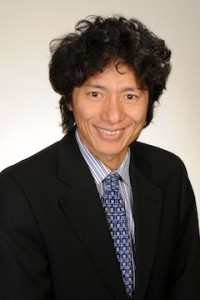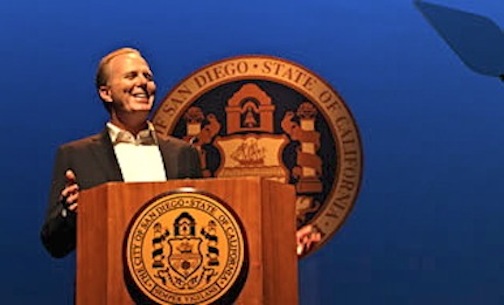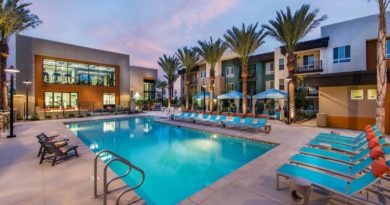Daily Business Report-Jan. 15, 2016
Mayor Kevin Faulconer (Photo: City of San Diego)
Mayor Faulconer: San Diego
Creating World Class City for All
Times of San Diego
San Diego Mayor Kevin Faulconer doubled down on his inclusive appeal for “one San Diego,” telling a public audience Thursday that through collaboration “we are creating a world-class city for all.”
“It’s been my goal to set a tone of collaboration, and focus on results,” he said, listing efforts to build new football stadium, improve city parks, expand the convention center and continue to invest heavily in street repair.
“We are creating a world class city for all,” he vowed.
Faulconer spoke to a capacity crowd of over 1,000 in his second State of the City Address at the historic Balboa Theatre in Downtown San Diego. The crowd included city and county officials, military leaders, and the mayor and other government officials from Tijuana.
“The foundation of our city is strong, and ladies and gentlemen the state of our city is strong,” he said.
Turning to the latest developments with the San Diego Chargers, he said the city has made more progress on a new stadium in the last 10 months than in the last 10 years.
He defended the plan to build a new stadium in Mission Valley, arguing that it’s “not to late to do what’s right for this team,” and suggesting no other city truly has the Chargers interests at heart.
“You can’t get that in LA. You can’t get that in Inglewood. You can only get that in San Diego,” he said.
Infrastructure would continue to be a top priority, with $10 million daily spent to repair and upgrade streets, sidewalks, libraries and parks.
And Faulconer vowed to bring a plan to expand the San Diego Convention Center Downtown to a public vote this year. “It’s time to settle this once and for all and get the convention center expanded,” he said.
_____________________________________________________
Study Says San Diego Attracts Some
Of the Best Scientific and Tech Minds
City News Service
More than 72,000 people with college degrees moved into San Diego in 2014, the most of any similar metropolitan area, the San Diego Regional Economic Development Corp. reported Thursday.
In a study of workforce talent, the EDC also found that the area ranked second in the increasing number of young adults — ages 25-34 — who hold college degrees.
However, the authors found that San Diego was eighth in the raw numbers of millennials with college degrees.
San Diego was compared to Austin, Baltimore, Boston, Denver, Pittsburgh, Portland, San Francisco, San Jose and Seattle — similar in size and economic makeup.
“Across the country, many economic development agencies and policymakers are focused on attracting companies to their regions,” said Mary Walshok, dean of UC San Diego Extension and an adviser on the study.
“The research tells us that economic developers should be focused on attracting talent instead,” Walshok said. “The good news is that in San Diego, we are attracting some of the best scientific and tech minds in the country. When it comes to talent growth and attraction, we are punching way above our weight.”
San Diego offers several traits that younger, educated workers would find attractive, according to the EDC.
The region had the shortest commute times of its peer cities, lowest employee turnover in technology and scientific research and development, ranked first in the concentration of scientific R&D firms and employment, and second in R&D average annual pay, the report said.
The EDC study found that the San Diego area trails its peer cities in several measurements, including residents with advanced degrees, net migration, job growth and cost-of-living — particularly for housing.
More Than $31 Million Awarded
To Water Projects in San Diego Region
13 projects will boost conservation, habitat, water recycling and more
The San Diego region has been awarded $31.1 million in grant money by the state Department of Water Resources for a variety of projects that will increase local water supplies, decrease water demands, improve water quality, manage stormwater, restore habitat and enhance species.
The awards announced Wednesday are part of the final round of Integrated Regional Water Management grants from voter-approved Proposition 84 (2006). Click here for the 13 funded projects and their local sponsors.
Tri-City Healthcare District to Pay $3.3M
Fine for Physician Contract Violations
Tri-City Healthcare District has agreed to pay a $3,278,464 fine in a settlement over medical staff contracting violations in 2009 that were voluntarily reported in 2011 by the district.
The settlement was announced by the district, the U.S. Department of Justice and Office of the Inspector General.
The settlement agreement resolves technical violations in physician contracts under the Stark Law as well as a civil claim. Tri-City Medical Center self-disclosed the violations in a letter to the Office of the Inspector General on July 20, 2011 and in a report submitted April 30, 2012.
The hospital executives that oversaw the contracting are no longer affiliated with Tri-City Medical Center and all of the medical center’s current physician contracts are in compliance with the Stark Law, according to district officials.
“It is unfortunate to have inherited this long-standing legal issue, but we are pleased to have brought it to a successful conclusion,” said CEO Tim Moran. “This is a clear indication that we must all strictly adhere to the guidelines set forth by all health care governing agencies.”
The settlement brings to resolution multiple technical violations and a civil claim involving physician contracts wherein certain arrangements exceeded fair market value and were considered not commercially reasonable.
Concentrated Poverty in
San Diego Suburbs on Rise
Using data released by the U.S. Census Department, the National University System Institute for Policy Research released a research brief showing how highly-concentrated poverty has grown in the region since 2000.
Researchers defined highly concentrated poverty as the number of individuals living below the federal poverty line who live in census tracts where at least 20 percent of their neighbors also live in poverty. The report found that the rate of highly concentrated-poverty has increased from 42.1 percent in 2000 to 45.6 percent in the years covered by the 2010-2014 American Community Survey.
Not only has poverty grown more concentrated over the past 15 years, it has also spread to the suburbs. Nearly half (49 percent) of residents living in highly concentrated poverty live outside of the city of San Diego. Notable increases have been seen in the city of El Cajon, Escondido, and the unincorporated areas of the county. In fact, the increase in poverty rate between 2000 and 2010-2014 in the city of San Diego was lower than 14 other cities in the County.
Tony Gwynn Jr. to Address Business Chamber
Tony Gwynn Jr., son of the late Padres great Tony Gwynn, will talk about perseverance in an appearance at a Jan. 19 luncheon sponsored by the North San Diego Business Chamber.
Gwynn will be introduced by his mother, Alicia Gwynn, and will be interviewed by event partner Pacific Western Bank following his presentation.
The program will be held beginning at 11 a.m. at Sony Electronics Inc., 16535 Via Esprillo, San Diego.
Researchers Develop Versatile
New Way to Build Molecules

Chemists at The Scripps Research Institute have devised a new and widely applicable technique for building potential drug molecules and other organic compounds.
The new method, reported in the Jan. 15 issue of the journal Science, enables researchers to add clusters of atoms called carbon fragment or functional groups to certain organic molecules more efficiently, robustly and selectively than current methods typically allow. It thus opens up new possibilities for chemists to assemble novel compounds that can be tested for useful properties in the development of drugs and other products.
“We demonstrated this technique with two broad classes of compounds, aldehydes and ketones — the ‘bread and butter’ of modern chemical synthesis,” said senior investigator Jin-Quan Yu, the Frank and Bertha Hupp Professor of Chemistry at TSRI.
Yu’s laboratory specializes in the development of techniques to make molecule-building easier, particularly for chemists trying to devise potential new drugs. Yu and his team have published more than a half-dozen of these innovations in Science or Nature in the past two years alone.
UC San Diego and Samsara Sciences
Team Up to Advance Liver Tissue Models
Researchers at University of California, San Diego School of Medicine and Samsara Sciences Inc., a wholly-owned subsidiary of Organovo Holdings Inc., have entered into an agreement focused on the development of techniques and methods for the isolation and characterization of liver cells that will help drive new research on liver biology, drug safety and efficacy, and the treatment of liver diseases.
The UC San Diego School of Medicine team consists of scientists in the laboratory of Tatiana Kisseleva, assistant adjunct professor in the Department of Surgery, and transplant surgeons directed by Alan Hemming, MD, professor and chief of transplantation and hepatobiliary surgery in the Department of Surgery.
In this collaboration, Kisseleva and her team will develop and optimize protocols for the isolation of specialized human liver cells. These cells will be used in Kisseleva’s own research at UC San Diego School of Medicine and characterized extensively with respect to phenotype and function in a broad spectrum of laboratory and animal models.
Samsara, a company specializing in the procurement, characterization and qualification of human cells for use in biological and pharmaceutical research, will apply these technological advancements in the commercial supply of specialized cells for use in bioprinted tissues and other cell-based models used in drug testing, disease modeling, drug discovery and regenerative medicine research.

John C. Stennis Carrier Strike Group
To Depart San Diego for Deployment
Ships and units from the John C. Stennis Carrier Strike Group will depart San Diego Jan. 19 and 20 for a regularly-scheduled deployment to the U.S. 3rd and 7th Fleet areas of operations.
The carrier strike group is also scheduled to participate in a kick-off event for “Great Green Fleet 2016” where Secretary of the Navy Ray Mabus, will bid farewell to the strike group on Jan. 20.
The strike group, carrying 6,200 sailors, will deploy as the centerpiece of the Great Green Fleet, a year-long initiative highlighting the Navy’s efforts to transform its energy use to increase operational capability. The strike group will use energy efficiency measures, to include technologies and operational procedures, and alternative fuel in the course of its normal operations.
The strike group consists of Nimitz-class aircraft carrier USS John C. Stennis, Carrier Air Wing 9, guided-missile cruiser USS Mobile Bay and three guided-missile destroyers from Destroyer Squadron 21, USS Stockdale, USS William P. Lawrence and Pearl Harbor, Hawaii-based USS Chung-Hoon.




